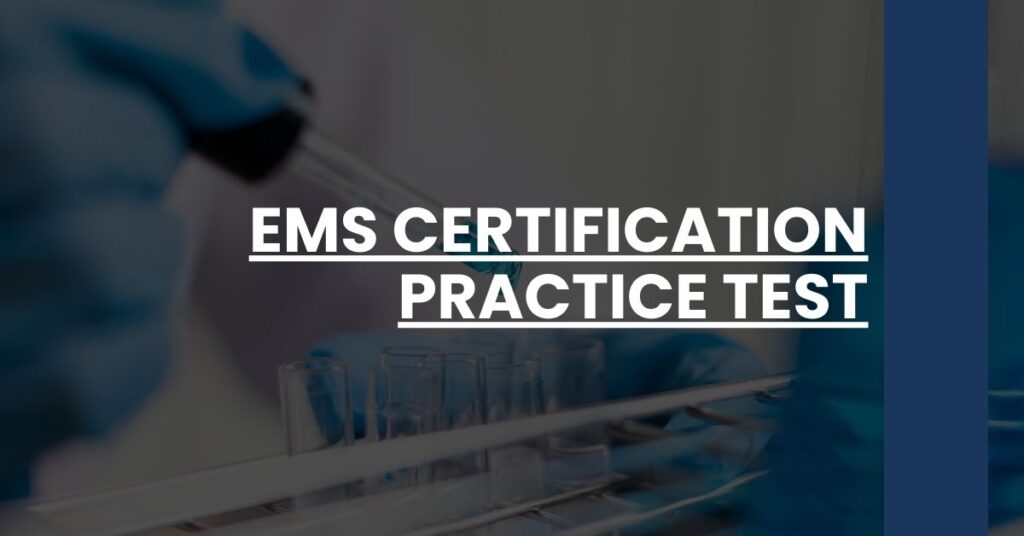EMS certification practice tests are your stepping stone to acing the big day with confidence.
- Tailored Test Preparation: Each practice test is designed to reflect the type of questions you’ll encounter in the actual EMS certification process.
- Immediate Feedback: Practice tests provide instant answers to gauge where your strengths and weaknesses lie.
- Confidence Building: Familiarity with the test format and question types effectively reduces pre-exam nerves.
Get the edge you need with EMS certification practice tests.
- Understanding EMS Certification
- Importance of Practice Tests for EMS Certification
- Finding the Right EMS Practice Tests
- The Structure of an EMS Certification Exam
- Effective Study Strategies for the EMS Exam
- Reviewing Practice Test Answers
- Time Management During the Exam
- Handling Exam Day Nerves
- Continual Learning Beyond Practice Tests
- Conclusion: Next Steps After Practice Tests
Understanding EMS Certification
Embarking on a career in emergency medical services (EMS) is a noble endeavor that requires dedication, skill, and a specific set of knowledge. EMS professionals are often the first to respond to medical emergencies, and their swift actions can make the difference between life and death. As such, the process of obtaining EMS certification is designed to ensure that all practitioners meet the necessary standards of care.
Certification Types:
- Emergency Medical Responder (EMR): This entry-level certification introduces basic life support and emergency care skills.
- Emergency Medical Technician (EMT): EMTs are trained to provide more comprehensive emergency services and transport patients.
- Advanced Emergency Medical Technicians (AEMT): These practitioners have more advanced skills, including some pharmacological interventions.
- Paramedic: The highest level of EMS certification, paramedics undergo extensive training to perform advanced medical procedures.
The path to certification typically involves completing a recognized educational program and passing both a practical and written examination, such as those administered by the National Registry of Emergency Medical Technicians (NREMT). Recertification is also part of the journey, requiring ongoing education to ensure EMS professionals’ skills remain sharp.
Importance of Practice Tests for EMS Certification
As you gear up for your EMS certification, practice tests become invaluable assets in your preparation arsenal. The significance of integrating EMS certification practice tests into your study routine cannot be overstated; they are not merely a study tool but a crucial component of your success strategy.
Practice Test Benefits:
- Question Familiarity: Practice tests offer a sneak peek into the types of questions you will encounter, helping you adapt to the exam’s depth and complexity.
- Exam Format: Understanding the structure of a test can significantly alleviate test anxiety, which can impact your performance.
- Identifying Knowledge Gaps: Regular practice enables you to pinpoint areas where your understanding may be lacking, guiding your study priorities.
- Confidence Building: With each practice test, your confidence grows, leading to a poised and composed mindset on the actual exam day.
Why Simulation Matters
Simulating the real test environment allows you to condition yourself mentally and physically for the actual exam. For instance, engaging in timed practice sessions hones your ability to manage the pressure of the ticking clock, a skill as critical as the medical knowledge itself.
Finding the Right EMS Practice Tests
In a sea of resources, the quest for high-quality EMS practice tests might seem daunting. Fret not, as we guide you through selecting the tools that will truly augment your study sessions.
Qualities of a Reliable Practice Test:
- Comprehensive Coverage: The best practice tests are those that encompass all exam subjects, providing a well-rounded review experience.
- Up-to-date Information: Given that medical guidelines evolve, ensure your practice questions reflect the latest EMS protocols.
- Rationale for Answers: Excellent practice tests come with explanations for correct answers — these insights are golden for deepening your comprehension.
A thorough search yields numerous online platforms such as Union Test Prep that offer free practice tests. However, ensure that the resource aligns with the certification level you’re aiming for, whether it’s EMT, AEMT, or Paramedic.
The Structure of an EMS Certification Exam
Embarking on your EMS certification exam requires an understanding of its anatomy — the core components that you will be tested on.
Core Content Categories
The EMS certification exams typically encompass the following areas:
- Airway, Respiration, & Ventilation: Proficiency in managing a patient’s airway and respiratory emergencies.
- Cardiology & Resuscitation: Skills and knowledge in handling cardiac emergencies and performing resuscitation.
- Medical & Obstetrics/Gynecology: Understanding of general medical emergencies and specialized care in obstetrics and gynecology.
- Trauma: Ability to assess and manage trauma-related emergencies.
- EMS Operations: Insights into the operational aspects and safety of EMS systems.
Understanding these categories in-depth helps you to allocate your study time effectively. Delving into resources like the NREMT’s exam breakdown can give you a clearer picture of what to expect and how to prepare.
Effective Study Strategies for the EMS Exam
Succeeding in your EMS certification exam is about more than just memorizing facts; it’s about synthesizing knowledge and applying it effectively under pressure.
Proven Study Tips
- Consistent Schedule: Create and adhere to a consistent study plan that includes daily review sessions.
- Diversify Learning Methods: Use a mix of textbooks, online courses, study apps, and group study to cater to different learning styles.
- Active Recall: Test yourself regularly with flashcards or oral quizzes to reinforce memory retention.
Resourceful tools like Limmer Education’s study apps can make learning more interactive and enjoyable, potentially improving information retention. By incorporating a variety of study materials and techniques, you prepare your mind to retrieve information in a dynamic testing environment.
Remember, effective preparation transcends reading; it’s an active, ongoing process that’s bolstered by resources such as EMS certification practice tests to bridge the gap between knowledge and application.
Reviewing Practice Test Answers
After you’ve completed your EMS certification practice test, the real learning begins. It is in the review phase that you convert mistakes into powerful learning opportunities.
Dissect Your Performance
Reviewing practice test answers should be a systematic exercise. Don’t just focus on the questions you got wrong. Understand why you got them right, too. This will reinforce the concepts you’re proficient in and affirm your knowledge.
- Spot the Patterns: Look for trends in the questions you missed. Are they clustered around specific topics or types of questions?
- Understand the Rationale: Analyzing the explanations for the answers unravels the reasoning behind them. This is crucial for questions you might have guessed.
- Highlight Uncertainties: If you were unsure about certain questions, even if you answered them correctly, it’s a sign you need to revisit the material.
Leveraging resources like Mometrix’s answer explanations, which delve into the reasoning processes for both correct and incorrect responses, can significantly deepen your understanding and ensure you don’t repeat the same mistakes.
Time Management During the Exam
Time management can make or break your performance on your EMS certification exam. You can know all the right answers, but without the ability to pace yourself, you might not get the chance to showcase that knowledge.
Pacing Strategies
Here’s how you can keep track of the ticking clock without breaking a sweat:
- Assess Question Complexity: Skim through the questions quickly at the start, identifying ones you can answer swiftly and those that need more reflection.
- Allocate Your Time Wisely: Decide how long you will spend on each question and stick to it.
- Resist the Rush: Don’t hurry through questions. A steady pace helps avoid careless errors.
To sharpen this skill, try practice tests under timed conditions to simulate the pressure of the exam day.
Handling Exam Day Nerves
Your EMS certification exam is a high-stakes situation, and it’s natural to feel anxious. However, managing these feelings is critical for maintaining focus and recall under pressure.
Calming Techniques
Keep your nerves in check with the following tactics:
- Routine Relaxation: Establish a pre-exam ritual that relaxes you, whether it’s deep breathing, listening to calming music, or visualizing success.
- Logical Self-Talk: Replace catastrophic thoughts with logical ones. Remind yourself of the preparation you’ve done and the knowledge you possess.
- Physical Preparedness: Get a good night’s sleep, eat a balanced meal, and stay hydrated.
Browse through a candidate handbook which often includes further suggestions for preparing mentally and physically for your certification test.
Continual Learning Beyond Practice Tests
Passing your EMS certification exam is a monumental step, but it’s just the beginning. In EMS, continuous learning is non-negotiable due to the ever-evolving nature of medical care.
Lifelong Learning Commitments
Keep these principles in mind as you move forward in your EMS career:
- Embrace Change: Stay abreast of new protocols and procedures. Medicine is dynamic, and so should be your knowledge.
- Seek Further Education: Whether it’s additional certifications or advanced degrees, always look for ways to grow professionally.
- Reflect and React: Regularly assess your experiences and lessons learned on the job to inform your practice.
Recognize that your certification is not an end but a gateway to a career that demands ongoing dedication to education, as evidenced by the continuing education requirements detailed for EMTs by resources such as Unitek EMT.
Conclusion: Next Steps After Practice Tests
In wrapping up, remember that your journey to EMS certification is a blend of knowledge acquisition, practical application, and self-awareness. EMS certification practice tests aren’t just tools for assessment; they’re instruments for building the intellect, reflexes, and confidence necessary to thrive in the fast-paced world of emergency medical services.
Encompass these preparatory steps in a comprehensive study plan that drives you not just to pass the exam but to excel in it. Transform the way you approach learning, and you’ll develop the caliber of expertise that doesn’t just pass tests but ultimately saves lives.
So, take another practice test, review your answers meticulously, and adjust your study plan accordingly. These iterative cycles of preparation will hone your abilities, ensuring you walk into your EMS certification exam ready to succeed.
EMS certification practice test resources and tips for aspiring EMTs to prepare, succeed, and enhance their exam readiness.

